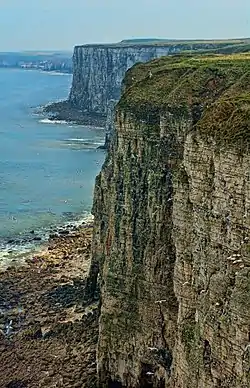Bempton Cliffs | |
|---|---|
 Bempton Cliffs looking towards Flamborough Head | |
 Bempton Cliffs | |
| Coordinates: 54°08′46″N 0°09′37″W / 54.146111°N 0.160278°W | |
| Grid position | TA 201 738 |
| Location | East Riding of Yorkshire, England |
Bempton Cliffs is a section of precipitous coast at Bempton in the East Riding of Yorkshire, England. It is run by the RSPB as a nature reserve and is known for its breeding seabirds, including northern gannet, Atlantic puffin, razorbill, common guillemot, black-legged kittiwake and fulmar. There is a visitor centre.[1]
Location
The hard chalk cliffs at Bempton rise are relatively resistant to erosion and offer many sheltered headlands and crevices for nesting birds. The cliffs run about 6 miles (10 km) from Flamborough Head north towards Filey and are over 330 feet (100 m) high at points.
The cliffs at Bempton are some of the highest chalk cliffs in England, Beachy Head in East Sussex being the highest at 530 feet (160 m).[2] The area administered by the RSPB also includes Buckton Cliffs.[3]
There are good walkways along the top of the cliffs and several well fenced and protected observation points.
Gannets
Bempton Cliffs is home to the only mainland breeding colony of gannets in England.[4] The birds arrive at the colony from January and leave in August and September.
Kittiwakes
Numerically the most common bird, around 10% of the United Kingdom population of kittiwakes (Rissa tridactyla) nest here.
Puffins
The Atlantic puffins (Fratercula arctica) at Bempton Cliffs tend to nest in rock crevices, whereas burrows are used at most UK sites. Although there are estimated to be around 958 birds (450 breeding pairs), it is relatively difficult to get a close view of them.[5] The puffins along the Yorkshire coast are now endangered.
The Bempton puffins mostly fly 25 miles (40 km) east to the Dogger Bank to feed. Their numbers may however be adversely affected by a reduction in local sand eel numbers caused by global warming, in turn caused by plankton being driven north by the 2 degree rise in local sea temperatures.[5]
References
- ↑ "Bempton Cliffs: revamped seabird centre opens". BBC News. 2015. Retrieved 18 August 2018.
- ↑ Rushby, Kevin (12 July 2013). "Flamborough Head, East Yorkshire: towering cliffs, by foot or by boat". The Guardian. Retrieved 6 April 2017.
- ↑ "Find Walks Bridlington Area". Walking the Riding. Retrieved 3 December 2019.
- ↑ "RSPB Website". RSPB. Archived from the original on 6 April 2010. Retrieved 4 April 2010.
- 1 2 "Puffins 'gone from Yorkshire coast in 10 years'". Yorkshire Post. 29 October 2015. Retrieved 6 April 2017.